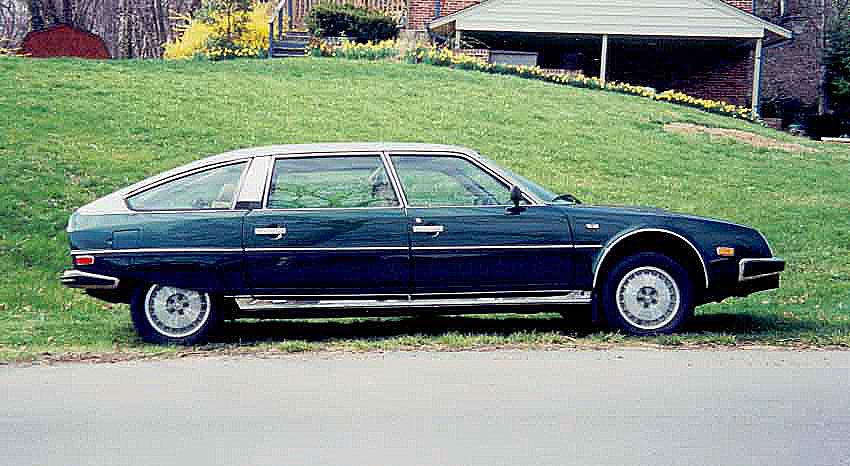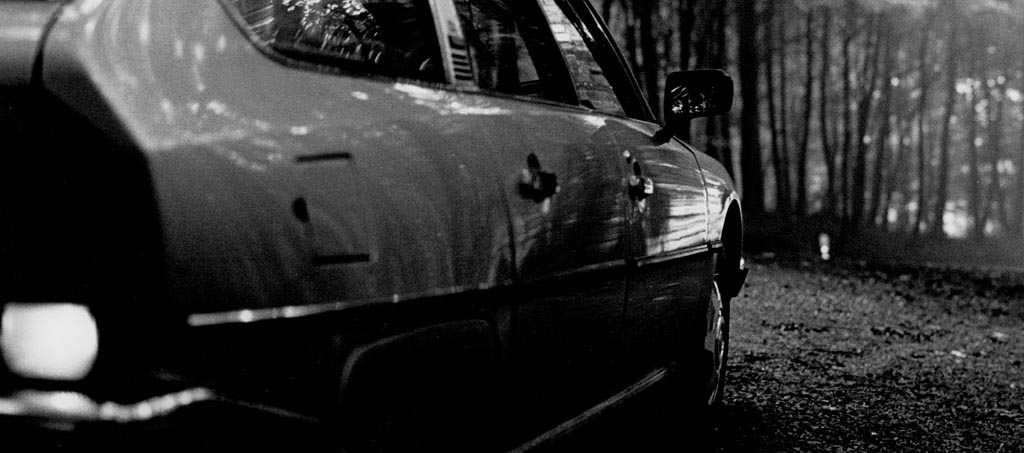The Citroën CX
Paul G. Robinson
To own a Citroën CX is to be individualistic. Some might even say odd, but they'd say that of all Citroën owners in the USA! The Citroën CX is considered by some to be the last true Citroën, designed completely free of outside influences. This is important because Citroën engineers were renowned for their innovation, ingenuity, and for looking at things from a very different perspective.
How else do you explain these wonderful cars? No other car in the world has a fully hydropneumatic suspension. Sure, Rolls Royce used it under license in the rear of their cars (high praise indeed) and other manufacturers have supplemented their suspensions with air and oil, but no one else has ever designed and mass produced such a suspension.
If you are not familiar with Citroën I'll try to explain a bit about the suspension. But keep in mind the suspension is only a part of the rest of the wonderful uniqueness of this car.
The CX, introduced in August of 1974 and produced until 1991, was the successor to the DS. The DS introduced, in 1955, the hydraulic system used in the CX, a central hydraulic system. More about that later. Because you should also know that the DS introduced, and the CX continued, aerodynamic styling that led the field. That's where the name CX comes from, it is the French scientific notation for aerodynamic drag co-efficient. In other words, how hard it is to push a thing through air.
The slippery design enabled Citroën to get fantastic speeds for the power available from the engine. You see, France had a taxation system that taxed cars as they became more powerful. So Citroën needed to get the most from lower power engines in their big cars to keep the cost down. The first CX model was capable of 108 mph with a 2.0 liter, 102 bhp engine! The last model, a turbocharged 2.5 liter 4 cylinder engine, was capable of 138 mph with 180 bhp and got to 60 mph in 7.7 seconds!

Well, back to the central hydraulic system. Central because the engine drives a hydraulic pump that pressurizes the fluid for use all over the car. It provides the braking force. It powers the steering and it powers the suspension. All with considerable provision for safety in the event of a leak or other failure.
The CX braking is top-notch partly due to this fully powered hydraulic system. With four-wheel disc brakes the calipers are fixed, the fronts using four pistons to press the pads into the disc, two on each side of the disc, the rears two pistons, one on each side. Through their aerodynamic studies Citroën realized they needed to get more air to the brakes so they used vented discs and an air scoop to the brakes in front.
With fully powered brakes the brake pedal doesn't have to do any work. The CX brake pedal is simply a valve with less than 1" of travel. Press it hard and fast and the car stops NOW! With a bit of practice braking is very easy to modulate and you begin to wonder why all cars aren't built this way. With the introduction of anti-lock brakes in the mid 1980s the CX reached its full braking potential.
CX steering is also fully powered, but not in any way that other cars are powered. The CX steering is not power assisted, it is fully powered. There is no mechanical connection between the steering wheel and the rack and pinion steering rack when the car is running. Hydraulic pressure does it all, with the rack fully pressurized. Because of this the steering wheel is bolted to a steering control unit.
The steering control unit provides powered self-centering of the steering wheel, so even when the car is stopped the steering wheel will return to straight from full lock. The steering control unit is also speed sensitive, making it harder to turn the steering wheel off-center as the car goes faster. With only 2.4 turns from lock to lock this becomes very important! Otherwise slight muscular twitches could send you into the next lane! As it is you actually 'think' the car around turns.
Because the steering rack is operated hydraulically it is not possible to turn the front wheels without using the steering wheel. Thus the car is completely unaffected by obstacles in the road or by flat tires, it just continues along the path set by the driver. This is aided by the use of center point steering geometry. Center point steering geometry is where the axis of the steering knuckle's ball joints intersects the center of the contact patch of the tire. With the tire/wheel pivoting 'dead center' on the contact patch there is very little leverage gained by objects pressing on one side of the tire tread, such as when crossing curbs. To say the car feels stable is an understatement!
Now about this suspension. The hydropneumatic suspension uses a gas-charged metal sphere as the spring and a calibrated entry port into the sphere as the shock absorber. Hydraulic fluid is forced into the sphere and the cylinder it is attached to. As more fluid enters the sphere the pressure of the gas and fluid reach equilibrium. More fluid is pumped in and the piston, attached to the suspension arm and inside the cylinder mentioned earlier, is pushed away from the sphere causing the car to rise.
The car's height is maintained by valves. When passengers enter, the car initially sinks down (the suspension is very soft) then is raised back up by the hydraulic system. Thus the car is self-leveling. The car's height can be changed by the driver using a lever between the seats (later an electric switch). Regardless of the number of passengers or how much luggage is loaded in the 16 cubic foot trunk the car remains at the proper height.
No springs. No shocks. And the softest, most compliant ride you'll ever experience. Many describe it as like riding on a cloud. But as soft as the ride is, it is very controlled. The front suspension employs anti-dive geometry so the car remains level and composed when braking. The CX does roll considerably in corners, but this was greatly improved in later years with the use of a stronger anti-roll bar up front.
So we have a great suspension. But the comfort of the CX doesn't
stop there. The seats are compared to living room chairs by new
passengers. They are very soft, almost overstuffed, but provide
good lumbar and lateral support. The seat cushions are longer
than most cars, supporting your leg to the back of the knee. After
a days driving you emerge from the car nearly as fresh as you started!
Still, as you sit in the car there are constant reminders that this car was designed by the French! For example, the instruments are in a 'pod' that seems to float in front of the driver. The first 12 years the car used a rolling speedometer and tachometer illuminated from behind (conventional instruments were used later). There is little other instrumentation. A long row of warning lights stretches the width of the pod above the instruments. All the critical controls, such as turn signals, horns, headlights and 4-way flasher are arranged to be at the driver's fingertips. Hold the steering wheel at 10 and 2 and you can operate every critical switch! The steering wheel has a single spoke, leaving the view of the instruments unobstructed. The remaining controls are less than an arms length away. Drop your right hand down and it rests on the climate controls. Since they are out of the line of sight the driver learns to operate them by feel, each control has a unique shape. The radio is just a slight reach forward, and the gear shift falls readily to hand.

The entire driving experience in a CX is so different that it does require some time to learn how to drive the car. The feeling is quite foreign to most drivers. But after some small amount of time behind the wheel most never want to return to their regular car. LJK Setright, the renowned automobile writer, wrote in Car Magazine in 1990, "Citroën's CX, 10 years on, still holds the most promise for the future." He goes on, " For the present, if I had to choose one car to serve equally well anywhere in Europe, Africa, or (and especially) America, and maybe elsewhere on roads with which I am not yet familiar; I do not see how it could be anything but the CX."
The CX is a car of high art. The great sweeping curve of the dash, the elegant and highly effective single windshield wiper, the functional arm rests in the doors all add to the sensation of being in one of the true exotic cars in existence. Form follows function in these cars, but with a style rarely seen in the mass market automobile. For that is what the CX is. To drive or even ride in a Citroën CX is unforgettable.

